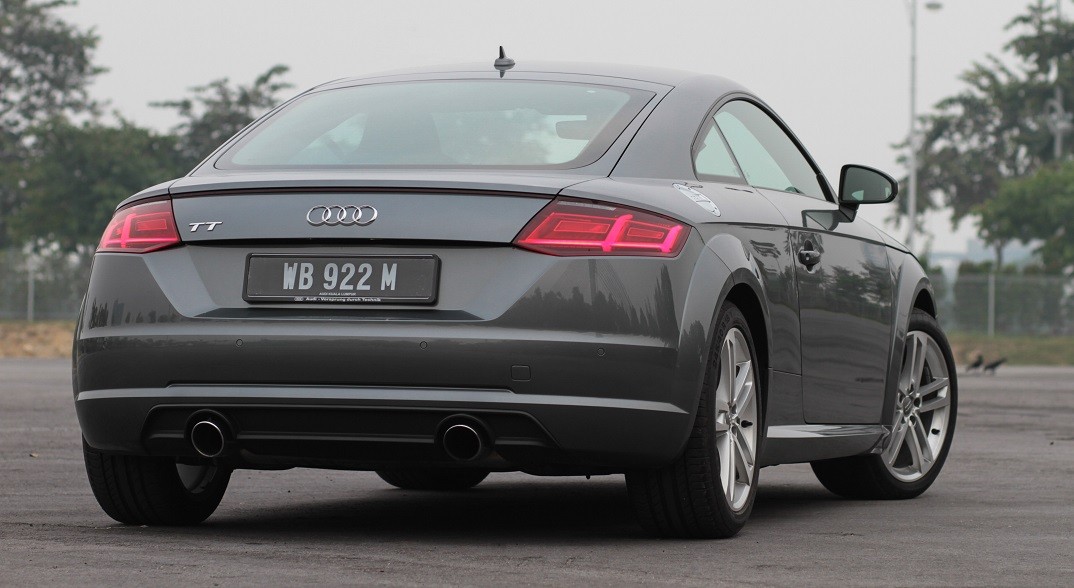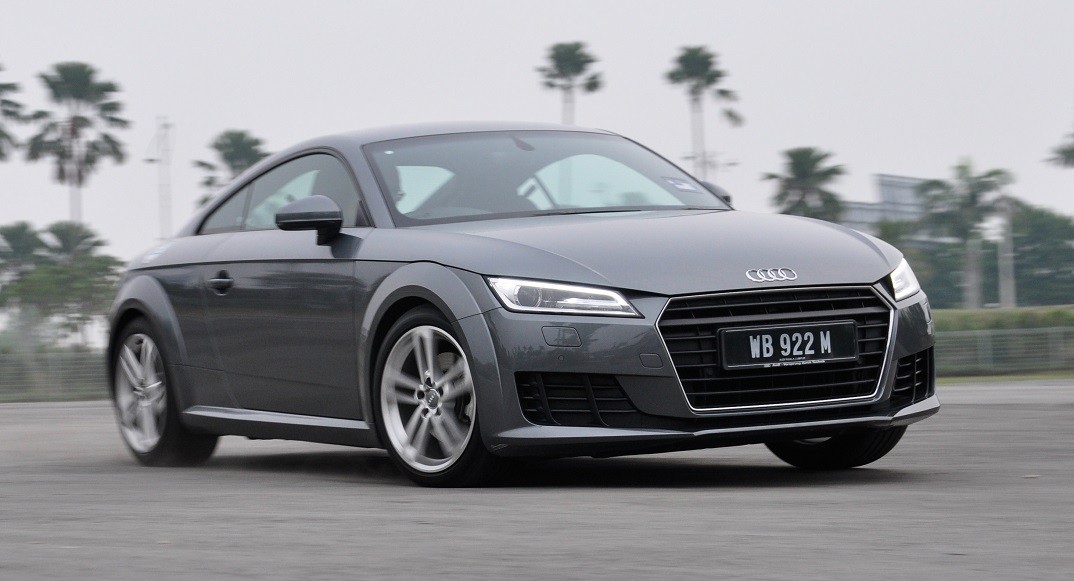On paper, the Audi TT’s winning recipe is straightforward: take the Volkswagen Golf’s underpinnings, shoehorn it and drape a sexy coupe skin over. While it’s no secret that German manufacturers love to “cover” each other in the name of competition, it’s astonishing how little opposition the TT have had to face since the original one took our collective breaths away back in 1998.
Achieving iconic status without actually mimicking a yesteryear icon (like the Mini or the Beetle) is proof that the Audi TT is already a modern classic, in only its third iteration. The beauty of the TT lies not merely in its sheet metal but in its concept. Like most sports coupes, the TT exists solely to gratify its owner, but cars with such singular focus typically entail a price tag that falls well beyond the realm of reasoning. It’s not the case with the Audi TT. This is a halo car that’s attainable, something you dare dream about.
Much more just evolutionary
While the looks of the third iteration won’t make a second generation owner seethe with envy, it’s much more than just evolutionary. Somehow, Audi has managed to position the third generation car in a design sweet spot; there’s healthy respect to the original, but with clear progress from the previous one. You’d know they’ve moved the game on even at first glance.
There is symmetry and balance in whichever angle you choose to study the TT. I like how every line on the body appear crisper, every edge sharper and every corner tauter than the previous car. Instead of being an element that stands out, the Nuvolari grille is now better integrated into a more purposeful-looking front end, flanked by slinky headlamps with LED running lights that give it a natural squint. In grey, our TT test car conjures up images of an F-22 Raptor stealth fighter.
 The high-tech imagery is all very deliberate of course, being an integral part of Audi’s ethos, but it’s perhaps the execution that separates Audi from the rest. Technology, or at least an overwhelming impression of it, envelops you the moment your derriere rests on the TT’s part-Alcantara leather seats. Beyond the chunky flat-bottom steering wheel resides a 12.3-inch digital display that constitutes what Audi calls the Virtual Cockpit – a new user interface that centres on de-cluttering the dashboard (no centre display and radio preset buttons) and channelling more interaction and information via the instrument binnacle.
The high-tech imagery is all very deliberate of course, being an integral part of Audi’s ethos, but it’s perhaps the execution that separates Audi from the rest. Technology, or at least an overwhelming impression of it, envelops you the moment your derriere rests on the TT’s part-Alcantara leather seats. Beyond the chunky flat-bottom steering wheel resides a 12.3-inch digital display that constitutes what Audi calls the Virtual Cockpit – a new user interface that centres on de-cluttering the dashboard (no centre display and radio preset buttons) and channelling more interaction and information via the instrument binnacle.
The high-resolution LCD is gorgeous to behold (it draws analogue dials that actually look a lot like the real thing), but accessing and scrolling through its sub-menus, either through the oversized MMI dial on the centre console or steering wheel switches, aren’t exactly the most intuitive of actions, though familiarity does come with judicious exploration, something best attempted when the car is stationary. Curiously, the driver-centric interface actually ends up hinders the front passenger from assisting in radio stations selection or working the navigation unless he/she peeps into the instrument binnacle.
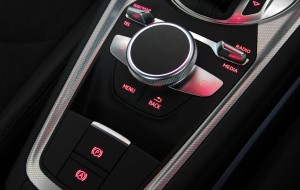 Otherwise, the cabin of the TT is a study of modernity and tasteful materials – aluminium inlays, satin chrome, Alcantara inserts and hardy plastics dominate. Oh, and mark these words: the cool Pratt and Whitney-inspired rotary vents incorporating air-con control dials will start trending from here on. Subscribers to the traditional school of luxury will find the expanse of grey in the TT cabin too clinical, dull even, but then again, you didn’t buy a TT for wood accents, did you?
Otherwise, the cabin of the TT is a study of modernity and tasteful materials – aluminium inlays, satin chrome, Alcantara inserts and hardy plastics dominate. Oh, and mark these words: the cool Pratt and Whitney-inspired rotary vents incorporating air-con control dials will start trending from here on. Subscribers to the traditional school of luxury will find the expanse of grey in the TT cabin too clinical, dull even, but then again, you didn’t buy a TT for wood accents, did you?
Teed up for a good time
It’s not a stretch to say that how well a TT performs is inextricably linked to the fortunes of the Golf. The first one that was based on the Mk 4 wasn’t pleasant at all to drive, but it didn’t matter because it awed everyone on looks alone. The second TT that took after the highly capable Mk 5 nailed both styling and driving appeal, but it was pricey car, at least in Malaysia.
Being based on Volkswagen’s MQB platform for transversely-mounted front engine models, the latest Audi TT was always going to be in good hands knowing how well the Golf Mk 7 behaved on the road. Powered by the GTI’s running gear, you get 230hp and 370Nm from the same turbocharged 2.0L four-cylinder mated to a 6-speed dual-clutch transmission (wet clutch type). Spec sheet indicates that this front-wheel-driven coupe is plenty fast, but behind the wheel, it feels like flying.
At some point in time, the industry needs to be ponder as to “how fast do we need everyday cars to be?”; 0-100km/h in 5.9 seconds and a restricted top speed of 250km/h puts the TT on level pegging with 1990s supercars such as the Ferrari 348 and Honda NSX. And we are talking about one of the least potent variants of the TT range.
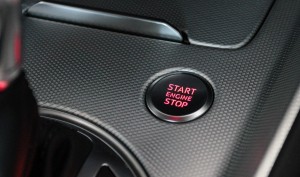 So yes, the acceleration will pin you to the seat when 370Nm (at 1,600rpm) is unleashed upon a coupe that weighs 1,335kg. But unlike the previous generation that would flash its ESC lamp incessantly when roads turn crappy, the new one is much, much more composed over uneven surfaces. Whether it’s through improved suspension geometry, damping or smarter calibration of the electronics (probably all), torque steer rarely manifests through the front axle, which means that at this state of tune, the TT doesn’t miss Quattro.
So yes, the acceleration will pin you to the seat when 370Nm (at 1,600rpm) is unleashed upon a coupe that weighs 1,335kg. But unlike the previous generation that would flash its ESC lamp incessantly when roads turn crappy, the new one is much, much more composed over uneven surfaces. Whether it’s through improved suspension geometry, damping or smarter calibration of the electronics (probably all), torque steer rarely manifests through the front axle, which means that at this state of tune, the TT doesn’t miss Quattro.
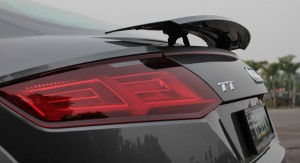 But because the TT has so much performance on tap, so much in-gear acceleration, feedback from its primary controls (e.g. steering and brakes) do come under heavier scrutiny. This is not an argument between hydraulic- or electric-assisted steering, the latter has won and is now the industry norm, and I personally do not miss hydraulic steering. Instead, it is about communicating nuances such as the expected increment of steering effort in tandem with increasing cornering speeds, something that the TT (and many Audis for that matter) is stingy with. This is not to be confused with grip levels in corners, of which the TT has in abundance, it is about the keen driver deriving that extra bit of confidence and reassurance when pushing on.
But because the TT has so much performance on tap, so much in-gear acceleration, feedback from its primary controls (e.g. steering and brakes) do come under heavier scrutiny. This is not an argument between hydraulic- or electric-assisted steering, the latter has won and is now the industry norm, and I personally do not miss hydraulic steering. Instead, it is about communicating nuances such as the expected increment of steering effort in tandem with increasing cornering speeds, something that the TT (and many Audis for that matter) is stingy with. This is not to be confused with grip levels in corners, of which the TT has in abundance, it is about the keen driver deriving that extra bit of confidence and reassurance when pushing on.
If it fits, it ships
 For a car that bears labels cautioning you not to slam the rear hatch onto passengers’ heads (the rear seats are best for inanimate objects, really), the TT is surprisingly easy to live with on a daily basis. You can take it slow because the S tronic transmission (a DSG in disguise) works just as good as any automatic (even has a “coasting” function to save fuel), you can drive it over bad city roads because the passive suspension set up, while firm, never jars. And you can cover long distances because it’s no less as refined as a Golf. By doing so many ordinary tasks well in a car that’s capable of pretty extraordinary things, it’s no wonder that the TT remains bereft of worthy challengers.
For a car that bears labels cautioning you not to slam the rear hatch onto passengers’ heads (the rear seats are best for inanimate objects, really), the TT is surprisingly easy to live with on a daily basis. You can take it slow because the S tronic transmission (a DSG in disguise) works just as good as any automatic (even has a “coasting” function to save fuel), you can drive it over bad city roads because the passive suspension set up, while firm, never jars. And you can cover long distances because it’s no less as refined as a Golf. By doing so many ordinary tasks well in a car that’s capable of pretty extraordinary things, it’s no wonder that the TT remains bereft of worthy challengers.
So here’s a note to self: work harder, start saving, secure donation.
Audi TT 2.0 TFSI
Price RM284,900 (incl. GST, w/o insurance)
Engine 2.0-litre, 4-cylinder petrol, turbocharged, 2WD
Output 230hp, 370Nm
Transmission 6-speed dual-clutch gearbox w/ manual mode
Performance 0-100km/h in 5.9 sec, top speed 250km/h (limited)
Wheels/tyres 18in alloys, 245/40 R18
Safety 6 airbags, electronic stabilisation control
Warranty 4-year/120,000km

